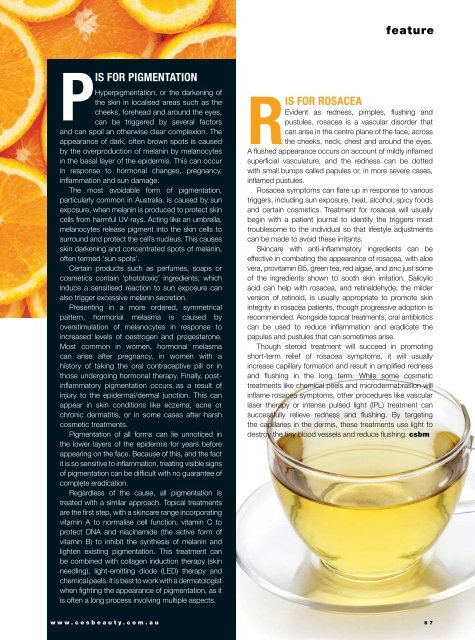Cosmetic Surgery and Beauty Magazine #68
You also want an ePaper? Increase the reach of your titles
YUMPU automatically turns print PDFs into web optimized ePapers that Google loves.
feature<br />
pis for Pigmentation<br />
Hyperpigmentation, or the darkening of<br />
the skin in localised areas such as the<br />
cheeks, forehead <strong>and</strong> around the eyes,<br />
can be triggered by several factors<br />
<strong>and</strong> can spoil an otherwise clear complexion. The<br />
appearance of dark, often brown spots is caused<br />
by the overproduction of melanin by melanocytes<br />
in the basal layer of the epidermis. This can occur<br />
in response to hormonal changes, pregnancy,<br />
inflammation <strong>and</strong> sun damage.<br />
The most avoidable form of pigmentation,<br />
particularly common in Australia, is caused by sun<br />
exposure, when melanin is produced to protect skin<br />
cells from harmful UV rays. Acting like an umbrella,<br />
melanocytes release pigment into the skin cells to<br />
surround <strong>and</strong> protect the cell’s nucleus. This causes<br />
skin darkening <strong>and</strong> concentrated spots of melanin,<br />
often termed ‘sun spots’.<br />
Certain products such as perfumes, soaps or<br />
cosmetics contain ‘phototoxic’ ingredients, which<br />
induce a sensitised reaction to sun exposure can<br />
also trigger excessive melanin secretion.<br />
Presenting in a more ordered, symmetrical<br />
pattern, hormonal melasma is caused by<br />
overstimulation of melanocytes in response to<br />
increased levels of oestrogen <strong>and</strong> progesterone.<br />
Most common in women, hormonal melasma<br />
can arise after pregnancy, in women with a<br />
history of taking the oral contraceptive pill or in<br />
those undergoing hormonal therapy. Finally, postinflammatory<br />
pigmentation occurs as a result of<br />
injury to the epidermal/dermal junction. This can<br />
appear in skin conditions like eczema, acne or<br />
chronic dermatitis, or in some cases after harsh<br />
cosmetic treatments.<br />
Pigmentation of all forms can lie unnoticed in<br />
the lower layers of the epidermis for years before<br />
appearing on the face. Because of this, <strong>and</strong> the fact<br />
it is so sensitive to inflammation, treating visible signs<br />
of pigmentation can be difficult with no guarantee of<br />
complete eradication.<br />
Regardless of the cause, all pigmentation is<br />
treated with a similar approach. Topical treatments<br />
are the first step, with a skincare range incorporating<br />
vitamin A to normalise cell function, vitamin C to<br />
protect DNA <strong>and</strong> niacinamide (the active form of<br />
vitamin B) to inhibit the synthesis of melanin <strong>and</strong><br />
lighten existing pigmentation. This treatment can<br />
be combined with collagen induction therapy (skin<br />
needling), light-emitting diode (LED) therapy <strong>and</strong><br />
chemical peels. It is best to work with a dermatologist<br />
when fighting the appearance of pigmentation, as it<br />
is often a long process involving multiple aspects.<br />
ris for rosacea<br />
Evident as redness, pimples, flushing <strong>and</strong><br />
pustules, rosacea is a vascular disorder that<br />
can arise in the centre plane of the face, across<br />
the cheeks, neck, chest <strong>and</strong> around the eyes.<br />
A flushed appearance occurs on account of mildly inflamed<br />
superficial vasculature, <strong>and</strong> the redness can be dotted<br />
with small bumps called papules or, in more severe cases,<br />
inflamed pustules.<br />
Rosacea symptoms can flare up in response to various<br />
triggers, including sun exposure, heat, alcohol, spicy foods<br />
<strong>and</strong> certain cosmetics. Treatment for rosacea will usually<br />
begin with a patient journal to identify the triggers most<br />
troublesome to the individual so that lifestyle adjustments<br />
can be made to avoid these irritants.<br />
Skincare with anti-inflammatory ingredients can be<br />
effective in combating the appearance of rosacea, with aloe<br />
vera, provitamin B5, green tea, red algae, <strong>and</strong> zinc just some<br />
of the ingredients shown to sooth skin irritation. Salicylic<br />
acid can help with rosacea, <strong>and</strong> retinaldehyde, the milder<br />
version of retinoid, is usually appropriate to promote skin<br />
integrity in rosacea patients, though progressive adoption is<br />
recommended. Alongside topical treatments, oral antibiotics<br />
can be used to reduce inflammation <strong>and</strong> eradicate the<br />
papules <strong>and</strong> pustules that can sometimes arise.<br />
Though steroid treatment will succeed in promoting<br />
short-term relief of rosacea symptoms, it will usually<br />
increase capillary formation <strong>and</strong> result in amplified redness<br />
<strong>and</strong> flushing in the long term. While some cosmetic<br />
treatments like chemical peels <strong>and</strong> microdermabrasion will<br />
inflame rosacea symptoms, other procedures like vascular<br />
laser therapy or intense pulsed light (IPL) treatment can<br />
successfully relieve redness <strong>and</strong> flushing. By targeting<br />
the capillaries in the dermis, these treatments use light to<br />
destroy the tiny blood vessels <strong>and</strong> reduce flushing. csbm<br />
www.cosbeauty.com.au 67


















